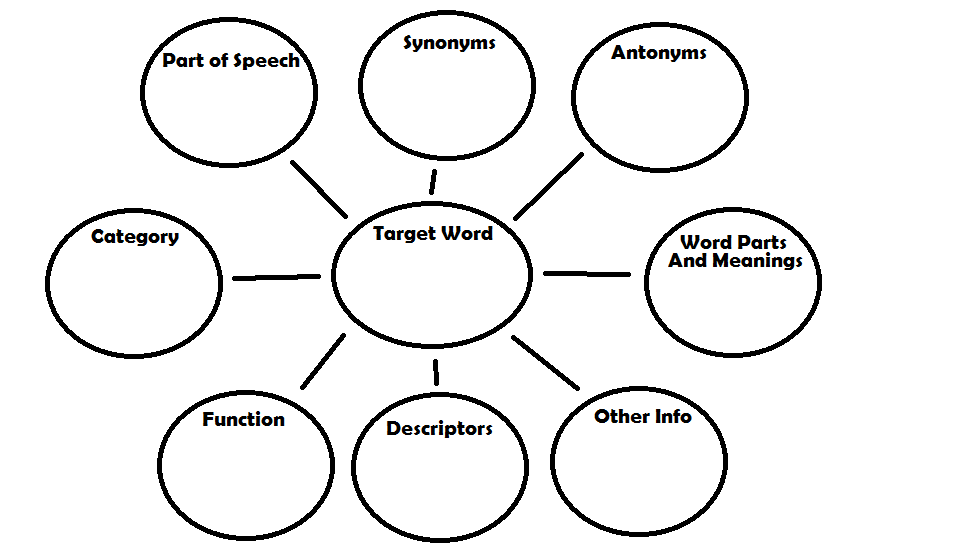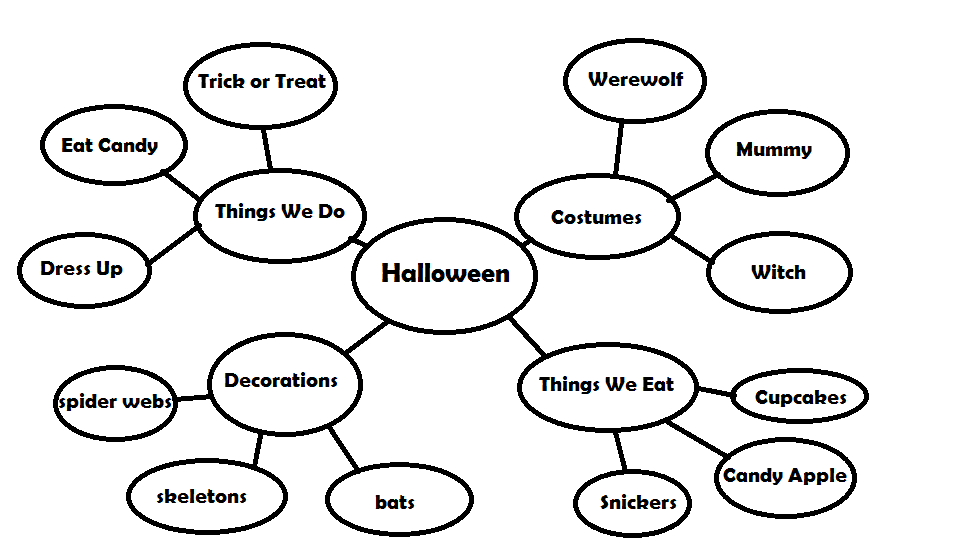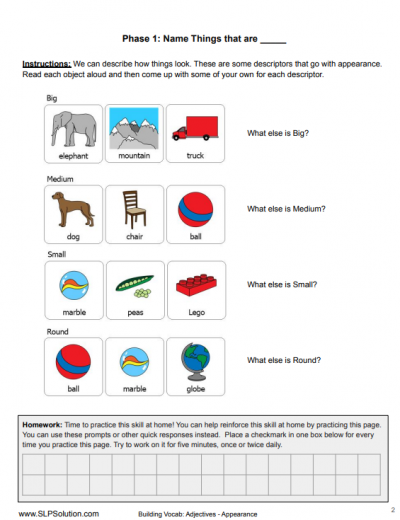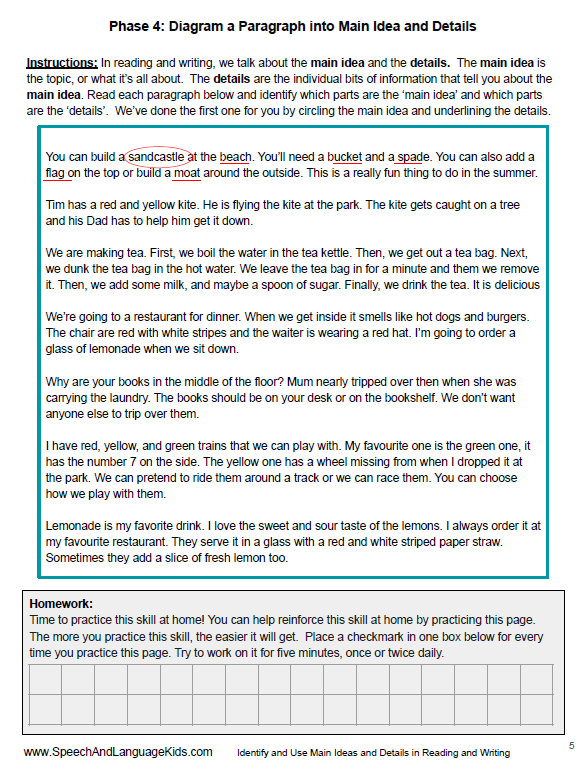What is a Word Web?
A word web is a graphic organizer that provides more information about a word. Word webs can help children learn new vocabulary words and connect those words to other words that they already know. This is a very effective tool for helping to boost vocabulary and language skills for all children, but especially those with language delays.
For more resources on helping boost vocabulary skills in children, click here.
Word Web Example 1:
Single Word Web
One way to use a word web to expand a child’s vocabulary is to find new words and discuss them at length. You can do this by creating a word web that maps out the new word. Go through a book with the child that is at or slightly above his reading level. Pick out a word from that book that the child doesn’t know the meaning of. You could also do this with an assigned reading from school. Chances are those words will come up again. Draw the following word web on a piece of paper. If desired, stick that paper in a page protector so that you can write on it with dry erase markers and use it again.

Write the target word in the middle of the word web and then fill in the circles that surround it. Use another piece of paper if you need more room. Here’s what to put in each circle:
Part of Speech:
Include if it is a noun (person/place/thing), verb (action word), adjective (describes a noun), adverb (describes a verb), preposition (location word like on and in), conjunction (combining words like and/but), interjection (ah ha! Or uh oh!).
Synonyms:
Identify words that mean the same thing as the target word.
Antonyms:
Identify words that mean the opposite of the target word.
Category:
If applicable, talk about what category the word belongs to. If it is a noun, use categories like “foods” or “clothing”.
Word Parts and Meaning:
Break the word apart into as many pieces as you can that still have some sort of meaning. For example, the words “balls” can be broken down into the root “ball” and the plural “s”. “Ball” means the object and “s” means there is more than one. For another example, “repositioning” could be broken down into “re” (again), “position” (movement or placing), and “ing” (currently happening). On the other hand, “butterfly” cannot be broken down any further as it is its own thing. If you broke it down into “butter” and “fly”, it would have a completely different meaning. Talk about the parts of the word and what each one means. This will help your child learn to decode other new words when he encounters them.
Function
If it is a noun, talk about the function of that object. If it is a different part of speech, talk about what role the word has in the sentence. For example, the conjunction brings two thoughts together.
Descriptors
For nouns, use the five senses to describe the word. How does it feel, look, taste, sound, and smell? For verbs, include what adverbs you could use to describe the action. For the word run, you could use “quickly”, “slowly”, “staggeringly”, etc.
Other Info
Include any other information that you have about that word.
After creating this word web with a child, he will have a much better understanding of what that word means. You could either erase these pages and start again (such as if you’re using dry erase markers), or put them together into a book for his own personal dictionary.
Word Web Example 2:
Vocabulary Web
If a child is struggling with vocabulary from a particular unit or theme at school, try creating a vocabulary word web for common words that the child might encounter. Here’s what you can do.
Pick a unit or theme and find an age-appropriate text about that topic. You can use the child’s textbook or find a book at the library. Go through the text with the child and pick out 20-30 words that seem to be key vocabulary for that unit. Many textbooks with include a list of key vocabulary at the beginning or end of the chapter. Write all of those words on a piece of paper.
Next, look at the list with the child and see if you can find similar traits that would allow you to group the words into categories on your word web. You could group them by part of speech (see the description above). You could also group them by topic. For example, words about The Earth may be grouped by land, water, and sky.
Once you have some groups in mind, create a word web that has the topic/unit in the middle in a circle. Then create more circles for your groups and have those branching off the topic. Finally, have each word in its own circle that branches off of one group. Here’s an example to get you started:

Keep creating these word webs and the child’s vocabulary will grow like crazy! You can even have your child decorate them and hang them where he can review them later.
Additional Resources for Teaching Vocabulary to Children
We have more resources for improving vocabulary skills in children. Check out our other materials here:

About the Author: Carrie Clark, MA CCC-SLP
Hi, I’m Carrie! I’m a speech-language pathologist from Columbia, Missouri, USA. I’ve worked with children and teenagers of all ages in schools, preschools, and even my own private practice. I love digging through the research on speech and language topics and breaking it down into step-by-step plans for my followers.
Fun Fact: Most of the pictures from my oldest version of products came from my roommate and I driving around Missouri taking pictures of things. We made a trip to the zoo, a farm, and other places so I could get a full, robust photo library to use for my images. So I apologize if the older stuff has some odd pictures. Sometimes things were just too hard to find and we had to improvise!
Connect with Me:










Thanks Carrie! I’m always looking for vocab ideas for clinic and even thought of an adaptation for the preschool.
Wonderful! Feel free to share that adaptation here so others can use it, too!
Your style is unique in comparison to other folks I have read
stuff from. Thanks for posting when you’ve got the opportunity, Guess I will
just bookmark this page.
Amazing article written by the author. Thanks for providing me in depth knowledge on how can I expand my vocabulary.
I love grammar! I have been brushing on some writing skills, and this blog helped make certain things very clear. Thank you so much!
You are very welcome, Fiona! Please let us know if you have any questions.
Interesting ideas that parents can follow through for their kids learning needs.